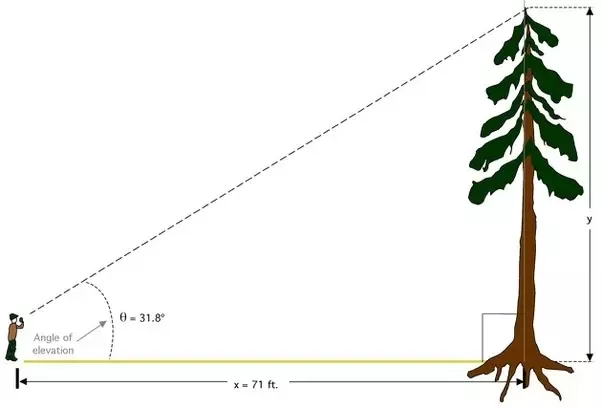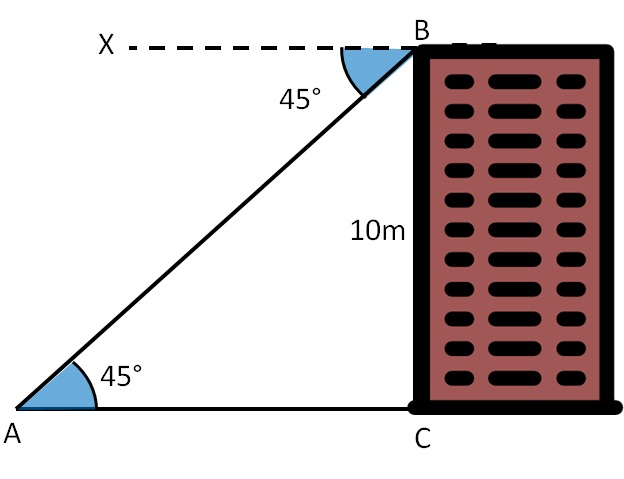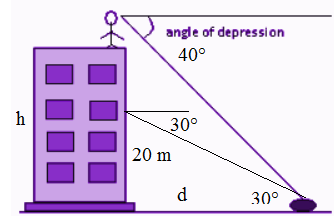Angle of Depression - Definition, Formula & Problems
The angle of depression is an angle formed by a horizontal line and a line of sight from a higher point to a lower point. It is used to describe the angle at which an object is viewed from above. For example, if you are standing on top of a hill and looking down at an object on the ground below, the angle of depression would be the angle between the horizontal line and the line of sight from your eyes to the object.
This Story also Contains
- Opposite of depression
- Depression meaning in geography
- Depression in Hindi
- Depression Meaning
- How to find the angle of elevation and depression
- Pictures that represent depression, the height of the depression
The angle of depression can be measured in degrees using a protractor or other angle-measuring tool. It is often used in trigonometry and geometry to solve problems involving angles and distances, such as finding the distance to an object based on its angle of depression.
In real-world applications, the angle of depression is often used in surveying, aviation, and navigation to measure the angle at which an object is viewed from above. It can also be used in engineering and construction to determine the slope of a surface or the height of an object.
Opposite of depression
Depression is a common mental health disorder characterized by persistent feelings of sadness, hopelessness, and a lack of interest or pleasure in activities. It can cause significant distress and interfere with daily functioning.
The opposite of depression is often described as being in a state of well-being or happiness. This can include feeling content, satisfied, and fulfilled, as well as having a positive outlook on life and a sense of purpose.
While it is not uncommon to experience occasional feelings of sadness or low mood, depression is different in that it is a persistent and often severe condition that can last for weeks, months, or even years. It can also cause physical symptoms such as fatigue, changes in appetite, and difficulty concentrating.
If you are experiencing symptoms of depression, it is important to seek help from a mental health professional. Treatment options may include therapy, medication, or a combination of both. With proper treatment, it is possible to manage and overcome depression and improve your overall well-being.
Depression meaning in geography
In geography, the term "depression" can refer to a low-lying area or a landform that is lower in elevation than the surrounding area. This can include natural features such as valleys, basins, and sinkholes, as well as man-made features such as quarries and pits.
Depressions can be formed through a variety of geological processes, including tectonic activity, erosion, and sedimentation. They can range in size from small, shallow features to large, deep basins.
In some cases, depressions can serve as important habitats for a variety of plant and animal species, particularly if they contain water or other resources. They can also be important sources of minerals and other natural resources, as well as being used for agriculture and other human activities.
It is important to note that the term "depression" in geography is unrelated to the mental health disorder of the same name. The mental health disorder of depression is characterized by persistent feelings of sadness and hopelessness, while depression in geography refers to a low-lying area or landform.
Depression in Hindi
In Hindi, the word "depression" (डिप्रेशन) refers to a mental health disorder characterized by persistent feelings of sadness, hopelessness, and a lack of interest or pleasure in activities. It can cause significant distress and interfere with daily functioning.
Depression is a common mental health condition that can affect people of all ages and backgrounds. It can be caused by a variety of factors, including genetics, life events, and physical health problems.
If you or someone you know is experiencing symptoms of depression, it is important to seek help from a mental health professional. Treatment options may include therapy, medication, or a combination of both. With proper treatment, it is possible to manage and overcome depression and improve overall well-being.
Depression Meaning
A mental health condition called depression is characterized by protracted feelings of melancholy, hopelessness, and a lack of enthusiasm for or enjoyment from activities. It can be extremely upsetting and interfere with day-to-day activities.
A persistently depressed mood can include feelings of sadness, anxiety, or emptiness; feelings of hopelessness or pessimism; a loss of interest or pleasure in once-enjoyable activities; difficulty focusing, remembering details, or making decisions; changes in appetite and sleep patterns; exhaustion or a lack of energy; and thoughts of death or suicide. People of different ages and socioeconomic backgrounds may be affected by depression, a prevalent mental health problem. Several things, including as genetics, life events, and physical health issues, can contribute to its occurrence.
A mental health expert should be consulted if you are exhibiting signs of depression. Therapy, medication, or a combination of the two may be used as a form of treatment. With the right care, depression may be controlled, conquered, and one's general wellbeing enhanced.
How to find the angle of elevation and depression
To find the angle of elevation or depression, you will need to use a bit of trigonometry. Here are the steps to follow:
Draw a diagram to represent the situation. The angle of elevation or depression is formed by a horizontal line and a line of sight from a higher or lower point.
Measure the distance between the two points. This is called the "horizontal distance."
Measure the height difference between the two points. If the higher point is above the lower point, this is the "height." If the lower point is above the higher point, this is the "depth."
Use the trigonometric functions sine, cosine, or tangent to find the angle. For example, if you are trying to find the angle of elevation, you can use the following formula:
angle = sin^(-1)(height/horizontal distance)
If you are trying to find the angle of depression, you can use the following formula:
angle = sin^(-1)(depth/horizontal distance)
Convert the result from radians to degrees if necessary. One full rotation is equal to 360 degrees, so to convert from radians to degrees, you can use the following formula:
degrees = radians * (180/pi)
It may be helpful to use a calculator or a trigonometry reference chart to help you solve these equations.
Pictures that represent depression, the height of the depression



Frequently Asked Questions (FAQs)
You could estimate the angle of depression, for instance, by standing on top of a hill or a structure and looking down at an object. A clinometer or a theodolite can be used to measure these angles
The angle of elevation is the angle between a person's horizontal line of sight and an item when they are standing and looking up at it. The angle of depression is the angle between the horizontal line of sight and the object when a person is standing and looking down at something.
The angle of depression is the angle formed by your line of sight and the horizontal (when looking down).
If the line of sight is directed downward from the horizontal line, then an angle is created with the horizontal line. The angle produced between the horizontal line and the observer's line of sight is known as the angle of depression if the object being observed is below the observer's level.
Always, the depression's angle is outside the triangle. It never falls within the triangle. From a horizontal line, it is at a downward angle. You might consider the angle of depression in terms of how your eyes move.